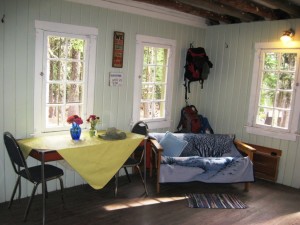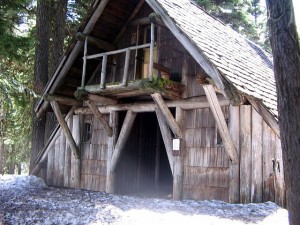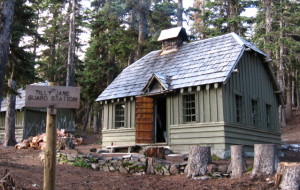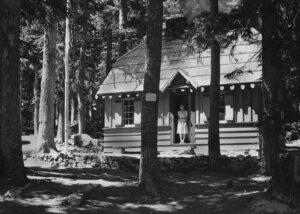 Reservations for Tilly Jane Cabin or A-frame can only be made through the Recreation.gov website.
Reservations for Tilly Jane Cabin or A-frame can only be made through the Recreation.gov website.
Most sources claim the Tilly Jane Guard Station was built in 1934 and initially received seasonal use for backcountry access and fire protection. The Ski Warming Hut (now known as the Tilly Jane A-Frame) was constructed by the Civilian Conservation Corps in the late 1930s. The Amphitheater and American Legion Cook Shed were constructed in the 1920s All together they have been designated part of the Cloud Cap – Tilly Jane Historic District that is under the supervision of the U.S. Forest Service. The Columbia Gorge and Portland Chapters of the Oregon Nordic Club have taken over responsibility for the maintenance, upkeep and scheduling use of the Guard Station and A-Frame respectively.. The amphitheater is still used occasionally for events but the cook shed is posted unsafe – no entry permitted.
Where did the name Tilly Jane originate? Tilly Jane was the jaunty nickname of Mrs. William Ladd of Portland. Mrs. Ladd must have been a delightful woman, for this creek is lovely in all seasons. Her husband, William, and C.E.S. Wood of Portland bought the Mt. Hood Trail and Wagon Road Co. in the Spring of 1889, renamed the firm the Mt. Hood Stage Co., and promptly began improvements that led to the Wagon Rd. The following is an excerpt from “Mount Hood, A Complete History” by Jack Grauer.
“There is a Tilly Jane Creek and a Tilly Jane Camp. They where both named for Tilly Jane Ladd, Wife of William Ladd, who in partnership with Colonel C.E.S. Wood, bought the Cloud Cap Road, and the Cloud Cap Inn from the Cooper-Coe-Stranahan partnership in 1889. The Ladds probably visited the area, prior to 1889, but perhaps not. However this gives a clue to when Tilly Jane Creek and Camp where named.
Long after the era of the Cooper tent camp, The Tilly Jane area was a popular place to camp. The Tilly Jane Guard Station was built on the north side Tilly Jane Creek in 1924, the time when the Hood River American Legion began to run their famous north side summit climbs. The trail into the creek canyon emerged on the south side to a side hill where they built the American Legion Cookhouse in 1924. Below and to the west, they built benches in an amphitheater style where people could sit and eat. In the evening, Legionaires conducted and early program before the climbers went to bed. These functions attracted crowds by the hundreds. Bus Gibson recalls a pre-climb evening after World War II, when about a thousand people partied in the area. Meanwhile, the hundred or so climbers lay in their sleeping bags, desperately trying to get a little sleep before the cruel march up the mountain began.
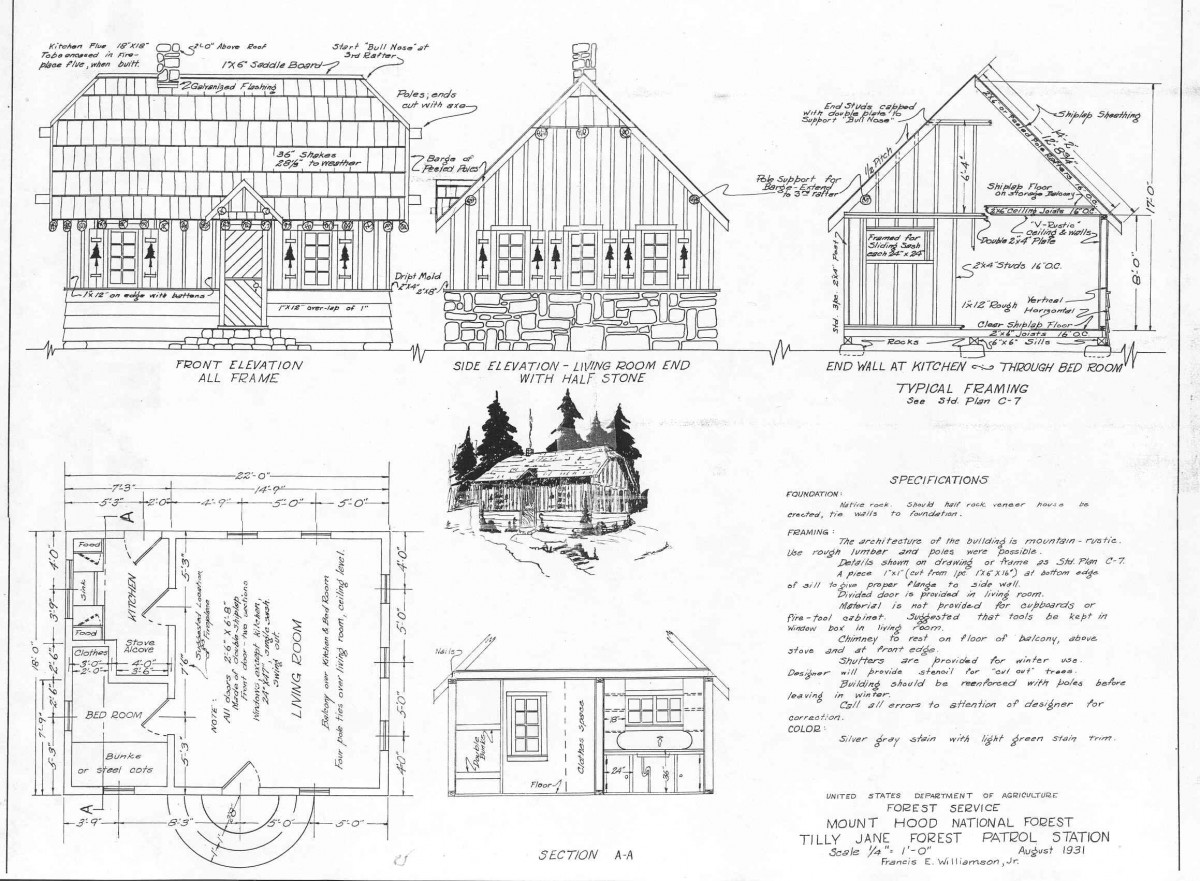
1931 Tilly Jane Plans
Just east of the Legion Cookhouse, is the A-frame shelter built by the CCC in 1939. This building, about 24’x48′, had a kitchen and dining hall on the ground floor and sleeping area above in a loft. The pit toilets were unique in that they where built into the structure, flanking the front entrance.
The Tilly Jane Ski trail runs past the door of the a frame on it’s 2.5 mile route for a drop of 1900 feet to the Cooper Spur Ski Area. The trail was brushed out in the winter of 1938-39 by Percy Bucklin, Bill Cochran, Harold Wells, and Walter Applegren. Cross country skiers find the twisting trail a challenge.”
The Tilly Jane Ski Trail is indeed a steep climb on skis from Cooper Spur ski area to the Tilly Jane cabins area. In summer and fall there is a road that leads up to Cloud Cap Inn, and the Tilly Jane Campground. But the road is gated when the first snows arrive, and usually does not open back up until all the snow is gone from the road, usually late June or early July. It is said the ski trail was used by American Legion climbing groups in the 20s and it is very possible that it was also used earlier by Native Americans and early settlers in the Hood River Valley. High alpine meadows were often used by valley sheepherders and the Tilly Jane Ski Trail is dotted with open meadows that may have enticed them to make the trek.
Tilly Jane Historic District News

